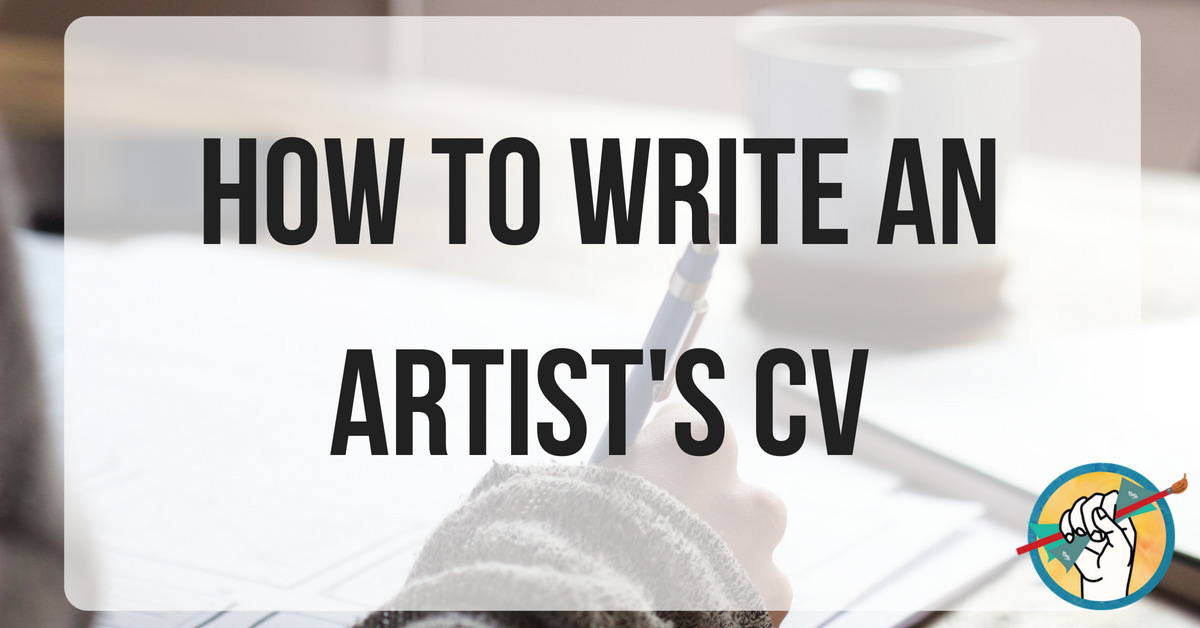A curriculum vitae is a necessary document if you hope to submit your work to galleries, collections, fine art exhibitions, etcetera.
In contrast with a resume, a CV highlights your professional accomplishments rather than your experience and qualifications. This is the place to list awards your art has received, exhibitions your art has been included in, collections where your art is held, and publications where you and your art have been featured.
For those whose art career hasn’t followed a straightforward trajectory of art school to professional career figuring out how to write an artist’s CV can feel intimidating. But it’s actually a really useful tool for you to highlight your accomplishments, conventional or not.

Header: Contact information
Keep this minimalist with a professional email address.
Leonardo da Vinci
555.555.5555
leonardodavinci.com
Education
Don’t worry- if you’re self taught, it’s okay to leave this part out. It won’t be considered a strike against you. If you’d like to include casual art classes or workshops you’ve attended here, the rule of thumb is to refer to them by the teacher you studied under, and not to draw attention to the more casual nature of the study. Only include education that’s relevant to your art career.
Example 1:
Studied under:
Andrea del Verrocchio
Example 2:
University of Oregon, Bachelor of Arts in Illustration, 2010
Exhibitions
This is the history of any exhibitions you’ve taken part in. If you haven’t yet partaken in any exhibitions, leave this out. If your work has been in more than 10 or 15 exhibitions, you can simply select the most impressive exhibitions to include. If you’ve taken part in 15 or fewer, you can list all of them. You can get creative here as long as you’re truthful- if your work was displayed in a coffee shop or a small private event, those are exhibitions.
It’s also acceptable to include exhibitions that you have lined up, but will happen in the future- list these as forthcoming.
2019 Leonardo da Vinci: A Life in Drawing, Belfast Royal Collection (forthcoming)
2018 da Vinci- The Genius, Boston Museum of Science
2018 da Vinci- The Genius, New Mexico Museum of Natural History
Collections
This is the place to list collections/museums where your work is held. This won’t apply to everyone, and it’s perfectly fine to leave it out. If your work is held in any collections, include the following information: title of the piece, name of the institution, city and state, and acquisition/donation date. It’s okay to include private collections as well- leave the name of the collector off in most cases and just include the location and the date.
The Last Supper. Convent of Santa Maria delle Grazie. Milan, Italy. Acquired 1490.
Publications:
Include here any publication you’ve had your work featured in- this includes newspapers, magazines, online articles, etc. If you’ve received a lot of published features, pick and choose the most impressive pieces to include here. If you’ve been featured in only a few, include them all! If you haven’t yet received any published attention, just leave this section off.
“Article title.” Publication title. Volume # (if applicable), date. Pages article appears on or link.
“The Secret Lives of Leonardo da Vinci.” The New Yorker. October 16, 2017. https://www.newyorker.com/magazine/2017/10/16/the-secret-lives-of-leonardo-da-vinci
Awards/Grants:
If you’ve received any awards or grants specifically for your artwork, include them here with the date first, followed by the name of the award and the awarding organization.
1495 The Leonardo da Vinci World Award, Leonardo da Vinci Association
Writing a CV when your art career is fairly new can feel intimidating. The key is to keep it simple and keep it relevant. Highlight your best accomplishments, leave off a section if it doesn’t apply to you, and remember that a CV is a living document and you will be able to update it regularly as you continue to work.
Do you have a CV written up, or have you used one to apply to galleries or exhibitions? What advice would you give to new artists looking to write their first CV? Let us know in the comments!
Need some more writing help?
How to Write Grants for Your Art Project
How to Write a Killer Sales Page
How to Write an Artist’s Statement that Doesn’t Suck
Interesting. On average, it takes 5-10 seconds to view one resume. A bit, right? That is why it is so important to immediately make a positive impression. Resume is self-promotion, which should present you with the best side and “sell” to the employer. Therefore, your task is to make all points of the resume “catchy”. Write simple sentences of 5-7 words. Avoid obscure contractions. Be sure to divide the text into paragraphs, choose a clear font. Use italics or bold to highlight headings. Remember that a resume should not exceed 2 pages. Ideally, 1 page. Good luck!
The focus of an artist’s CV is to highlight your artistic training, exhibition history and significant career achievements. The important thing is to keep it simple, clear and easy to read with well defined categories. A typical CV is between one to four pages long and the layout should be kept simple. Stick to standard font and font sizes and always proofread the CV before sending it out to avoid any spelling mistakes. Also make sure the CV is current and up to date before submitting it.
Thanks for this article.